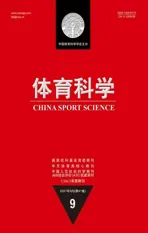4 min跑步和自行车全力运动中运动方式对有氧供能比例的影响
2016-12-14黎涌明陈小平乌里哈特曼
黎涌明,陈小平,乌里·哈特曼
4 min跑步和自行车全力运动中运动方式对有氧供能比例的影响
黎涌明1,2,陈小平3,乌里·哈特曼4
拟探究4 min全力跑步和自行车运动中运动方式对有氧供能比例的影响。方法:招募了16名铁人3项、自行车和长跑业余爱好者(年龄33.5±10.6岁,身高180±9 cm,体重75.8±8.4 kg,训练年限14±10年),以4 min全力(室外田径场)跑步和功率自行车为例,比较了两种运动方式的能量供应和摄氧量动力学特征。使用便携式气体代谢仪和血乳酸分析仪对运动过程中的能量代谢指标进行了测试和分析,运用基于运动中累积摄氧量、累积血乳酸和运动后过量氧耗的快速部分的计算方法对能量供应量进行了计算。结果:4 min全力跑步和自行车的有氧供能比例没有显著差异(77.0±3.8% vs.75.9±2.6%,P>0.05),磷酸原供能比例没有显著区别(11.4±2.6% vs.10.0±2.0%,P>0.05),糖酵解供能比例存在显著差异(11.6±3.4% vs.14.1±3.3%,P<0.05)。两种运动方式的摄氧量动力学快速部分相似(16.2±3.69 s vs.14.5±4.84 s,P>0.05),慢速部分幅度存在显著差异(0.26±0.09 L/min vs.0.54±0.32 L/min,P<0.05)。结论:4 min全力跑步和自行车的研究结果似乎表明,运动方式并不影响全力运动中的有氧供能比例,此结论的得出还有待对其他运动方式和其他持续时间研究印证。
跑步;自行车;有氧供能比例;摄氧量动力学
1 前言
人体运动是一个将生物能转换为机械能的过程,这一过程包括生理学方面产生能量和生物力学方面利用能量两个环节[2]。人体能量的产生包括磷酸原、糖酵解和有氧供能3个途径,其中有氧供能量占所有供能量的比例被称为有氧供能比例[18]。有氧供能比例是人体全力运动的一个重要生物学特征,对其的描述最早可追溯到Astrand等人1970年的著作(Textbook of work physiology)[5],该书第一次给出了有大肌肉参与的全力运动所对应的有氧供能比例,如2 min的全力运动所对应的有氧供能比例为50%。这些对全力运动有氧供能比例的描述被后续众多运动生理学和运动训练学著作所引用[11,21,29],然而,这些描述都没有提及运动方式对全力运动有氧供能比例的可能影响。尽管综述不同运动方式(包括跑步、自行车、游泳、划船等)有氧供能比例的相关研究可以得到全力运动持续时间和有氧供能比例的相关性公式(y=22.404×Ln(x)+45.176)[3,25],但这并不能排除运动方式对全力运动有氧供能比例的潜在影响。运动方式对全力运动有氧供能比例的影响有待专门的实验研究。

鉴于此,本研究拟选取跑步和自行车这两种运动方式,比较特定运动时间(4 min)内两种运动方式的有氧供能比例,探究运动方式是否影响全力运动时的有氧供能比例,为全力运动持续时间和有氧供能比例的相关性公式在不同运动方式间的应用提供理论基础。由于本研究属于系列研究的一部分[24],在整体设计中,本研究的数据被用于与4 min的皮划艇运动(对应为皮划艇奥运项目1 000 m的比赛持续时间)进行对比,因此,本研究所选取的持续时间为4 min。
2 研究对象与方法
2.1 研究对象
16名来自铁人3项、长跑和自行车项目的健康男性业余爱好者(年龄33.5±10.6岁,身高180±9 cm,体重75.8±8.4 kg,训练年限14±10年)自愿参加本次测试,并签署知情同意书。所有受试者熟知测试流程、要求和可能存在的危险,在测试前一天未参加剧烈身体活动,测试当天保持正常高糖饮食习惯,测试前2 h内未进食。
2.2 研究方法
所有受试者在1周内参加2次4 min的全力(time trial)运动测试(跑步和自行车,二者顺序为随机),两次测试间隔>24 h。跑步测试在室外400 m标准塑胶跑道进行,自行车测试在实验室内的电阻式功率自行车(Lode Excalibur Sport,Lode.,BV,Groningen,The Netherlands)上进行。测试前,受试者先进行10 min自选强度的准备活动,休息5 min后开始全力运动。受试者采用自选体力分配方式(pacing strategy)完成全力运动,以在4 min内完成尽可能多的距离或做功。测试过程中给予口头鼓励,尽量确保受试者全力参与测试。自行车测试前根据受试者的自感舒适度调整功率自行车的座位和扶手位置,测试过程中要求受试者尽量保持90 rpm的骑频。两类测试所对应的温度、气压和湿度分别为15~25℃、995~1 010 mbar和30%~60%。
运用便携式气体代谢仪(MetaMax 3B,Cortex Biophysic,Leipzig,Germany)对受试者全程进行气体代谢测试,包括10 min准备活动、5 min休息、4 min全力运动和运动后6 min休息。测试前按照仪器使用要求进行气压、气体(标准气体浓度O2为15.00%,CO2为5.00%)和气量(气筒容积为3 L)校准。采集准备活动前后、全力运动前后和全力运动后第1、3、5、7和10 min的耳血20 μl,并用血乳酸分析仪(Biosen S_line,EKF Diagnostic,Barleben,Germany)进行分析。

阶段1(心动力部分)
+A1×(1-e-(t-TD1/τ1)
(1)
阶段2(快速部分)
+A2×(1-e-(t-TD1/τ2)
运用配对t检验(SPSS Statistics 19,IBM Corporation,New York,USA)对跑步和自行车相关指标进行显著性检验,选取P=0.05的显著性水平。
3 研究结果

4 min全力跑步和自行车的能量供应比例见图2,跑步和自行车两种运动方式在磷酸原(11.4±2.6% vs.10.0±2.0%)和有氧供能比例(77.0±3.8% vs.75.9±2.6%)上没有显著性差异(P>0.05),但是,在糖酵解供能比例上却存在显著性差异(11.6±3.4% vs.14.1±3.3%,P<0.05)。

表1 4 min跑和自行车全力运动相关代谢指标及动力学指标

图1 1名受试者(7号)4 min跑步和自行车全力运动对应的示意图
4 讨论


图2 4 min跑和自行车全力运动的能量供应比例示意图



当然,本研究一方面只选取了两种常见的运动方式(跑步和自行车)进行研究,且这两种运动方式在肌肉参与部位(下肢都参与)和参与量方面都较为接近,所得到的结论能否适用于其他运动方式还不清楚。另一方面,本研究只对某一特定持续时间(4 min)进行了研究,这一特定持续时间属于有氧供能主导的时段(>75 s[3,18]),所得到的结论能否适用于其他无氧供能主导的时段(<75 s[3,18])也不清楚。因此,运动方式是否影响全力运动有氧供能比例这一科学问题,还有待未来对更多的运动方式(如上肢类运动方式)和其他持续时间(如30 s、1 min、2 min等)进行研究。
5 结论
本研究以4 min全力跑步和自行车为例,探究了运动方式是否影响全力运动的有氧供能比例,结果显示,4 min全力跑步和自行车的有氧供能比例没有显著性差异。Astrand等人对全力运动有氧供能比例的描述,以及基于文献综述得到的全力运动持续时间和有氧供能比例的相关性公式,似乎可以应用于不同的运动方式。但是,此结论的得出还有待对其他更多的运动方式和其他不同的持续时间进行研究。
[1]黎涌明.摄氧量动力学—历史、特征和启示[J].武汉体育学院学报,2015,49(3):63-69.
[2]黎涌明,纪晓楠,资薇.人体运动的本质[J].体育科学,2014,34(2):11-17.
[3]黎涌明,毛承.竞技体育项目的专项供能比例—亟待纠正的错误[J].体育科学,2014,34(10):93-96.
[4]ACHTEN J,VENABLES M C,JEUKENDRUP A E.Fat oxidation rates are higher during running compared with cycling over a wide range of intensities[J].Metabolism,2003,52(6):747-752.
[5]ASTRAND P O,RODAHL K.Textbook of Work Physiology[M].New York:McGraw-Hill,1970.
[7]BARSTOW T J,JONES A M,NGUYEN P H,etal.Influence of muscle fiber type and pedal frequency on oxygen uptake kinetics of heavy exercise[J].J Appl Physiol,1996,81(4):1642-1650.
[8]BENEKE R.Maximal lactate steady state concentration(ML-SS):Experimental and modelling approaches[J].Eur J Appl Physiol,2003,88(4-5):361-369.
[9]BIJKER K E,DE GROOT G,HOLLANDER A P.Delta efficiencies of running and cycling[J].Med Sci Sports Exe,2001,33(9):1546-1551.

[11]BOMPA T O,HAFF G G.Periodization- theory and Methodology of Training[M].Champaigh:Human Kinetics,2009.22-29.
[12]CAPUTO F,DENADAI B S.Effects of aerobic endurance trai-ning status and specificity on oxygen uptake kinetics during maximal exercise[J].Eur J Appl Physiol,2004,93(1-2):87-95.
[13]CAPUTO F,MELLO M T,DENADAI B S.Oxygen uptake kinetics and time to exhaustion in cycling and running:a comparison between trained and untrained subjects[J].Arch Physiol Biochem,2003,111(5):461-466.
[14]CARTER H,JONES A M,BARSTOW T J,etal.Oxygen uptake kinetics in treadmill running and cycle ergometry:A comparison[J].J Appl Physiol,2000,89(3):899-907.
[15]CIBA-GEIGY.Wissenschaftliche Tabellen Geigy[M].Basel:Ciba-Geigy,1985.
[16]DI PRAMPERO P E.Energetics of muscular exercise[J].Rev Physiol Biochem Pharmacol,1981,89:143-222.
[17]FRAUENDORF H,KOBRYN U,GELBRICH W.Blutdruck-und Herzschlagfrequenzverhalten bei fünf verschiedenen Formen dynamischer Muskelarbeit[J].Zeitschrift für Arbeitswissenschaft,1990,44(4):214-216.
[18]GASTIN P B.Energy system interaction and relative contribution during maximal exercise[J].Sports Med,2001,31(10):725-741.
[19]GREENHAFF P L,HULTMANN E,HARRIS R C.Carbohydrate Metabolism[M].Principles of Exercise Biochemistry.Basel:Karger,2004.
[20]HILL D W,HALCOMB J N,STEVENS E C.Oxygen uptake kinetics during severe intensity running and cycling[J].Eur J Appl Physiol,2003,89(6):612-618.
[21]HOLLMANN W,STRUEDER H K.Sportmedizin:Grundlagen fuer Koerperliche Aktivitaet,Training und Praeventivmedizin[M].Stuttgart:Schattauer,2009:68,501-507.
[22]JONES A M,POOLE D C.Oxygen uptake dynamics:From muscle to mouth-an introduction to the symposium[J].Med Sci Sports Exe,2005,37(9):1542.
[23]KNUTTGEN H G.Oxygen debt after submaximal physical exercise[J].J Appl Physiol,1970,29(5):651-657.
[24]LI Y.Energetics in Canoe Sprint[M].University of Leipzig.Doctor,2015.
[25]LI Y,NIESSEN M,CHEN X,etal.Overestimate of relative aerobic contribution with maximal accumulated oxygen deficit:A review[J].J Sports Med Phys Fit,2015,55(5):377-382.
[26]MARGARIA R,EDWARDS H T,DILL D B.The possible mechanism of contracting and paying the oxygen debt and the role of lactic acid in muscular contraction[J].Am J Physiol,1933,106:689-714.
[27]MILLET G P,VLECK V E,BENTLEY D J.Physiological differences between cycling and running:Lessons from triathletes[J].Sports Med,2009,39(3):179-206.
[28]ORIE J,HOFMAN N,DE KONING J J,etal.Thirty-eight years of training distribution in Olympic speed skaters[J].Int J Sports Physiol Perform,2014,9(1):93-99.
[29]POWERS S K,HOWLEY E T.Exercise Physiology:Theory and Application to Fitness and Performance[M].New York:Mc Grow Hill,2007:33-38.
[30]PRINGLE J S,DOUST J H,CARTER H,etal.Oxygen uptake kinetics during moderate,heavy and severe intensity "submaximal" exercise in humans:The influence of muscle fibre type and capillarisation[J].Eur J Appl Physiol,2003,89(3-4):289-300.
[31]ROBERTS A D,MORTON A R.Total and alactic oxygen debts after supramaximal work[J].Eur J Appl Physiol,1978,38(4):281-289.
[32]SANDALS L E,WOOD D,DRAPER S B,etal.Influence of pacing strategy on oxygen uptake during treadmill middle-distance running[J].Int J Sports Med,2006,27(1):37-42.
[33]SCOTT C B,LITTLEFIELD N D,CHASON J D,etal.Differences in oxygen uptake but equivalent energy expenditure between a brief bout of cycling and running[J].Nutr Metab(Lond),2006,(3):1-5.
[34]STEGMANN J.Leistungsphysiologie:Physiologische Grundlagen der Arbeit und des Sports[M].Stuttgart:Georg Thieme Verlag,1991:56-59.
Influence of Exercise Modalities on Relative Aerobic Energy Contribution in 4 min Running and Cycling Time Trial
LI Yong-ming1,2,CHEN Xiao-ping3,HARTMANN Ulich4
Aim The relative aerobic energy contribution is a fundamental characteristic of maximal exercises.Previous investigations have reported some values of relative aerobic energy contribution,or some correlation equation,for different duration of maximal exercises,without verifying the influence of exercise modalities.The aim of this study is to investigate the influence of exercise modalities on relative aerobic energy contribution in 4min running and cycling time trial.Methods This study recruited 16 amateur athletes from triathlon,cycling,and long-distance running (33.5±10.6 yrs,180±9cm,75.8±8.4 kg,training experience 14±10 yrs) to participate in two 4min time trails,with the exercise modalities of field-running,and ergometer-cycling.The energy contributions and oxygen uptake kinetics were compared for these two exercise modalities.We utilized a portable gas analyzer and a blood lactate analyzer to measure and assess the relative parameters.The energy contributions were calculated with the method based on the accumulated oxygen uptake,and blood lactate during the maximal exercise,as well as the fast component of the oxygen debt during the recovery.Results The results demonstrated similar aerobic energy contributions (77.0±3.8% vs.75.9±2.6%,P>0.05),similar phosphate energy contributions (11.4±2.6% vs.10.0±2.0%,P>0.05),but significantly different glycolysis energy contributions (11.6±3.4% vs.14.1±3.3%,P<0.05) between running and cycling.The oxygen uptake kinetics were similar in the fast component(16.2±3.69 s vs.14.5±4.84 s,P>0.05),but significant different in the slow component(0.26±0.09 L/min vs.0.54±0.32 L/min,P<0.05).Conclusion The results from the 4min time trials of running and cycling indicate seemly that the exercise modalities don’t influence the relative aerobic energy contribution in maximal exercises.This conclusion warrants future investigations which emphasize on more exercise modalities,and more duration.
running;cycling;aerobicenergycontribution;oxygenuptakekinetics
1000-677X(2016)09-0048-06
10.16469/j.css.201609007
2016-01-11;
2016-08-11
国家自然科学基金项目(31500963);上海市人类运动能力开发与保障重点实验室(上海体育学院)项目资助(11DZ2261100)。
黎涌明(1985-),男,湖南汨罗人,博士,副教授,博士研究生导师,主要研究方向为人体运动的动作和能量代谢特征,Tel: (021)51253467,E-mail:59058729@163.com;陈小平,(1956-),男,山东武城人,博士,教授,博士研究生导师,主要研究方向为运动训练,Tel:(0574)87600227,E-mail:chenxiaoping@nbu.edu.cn;乌里·哈特曼,(1953-),男,德国波恩人,博士,教授,博士研究生导师,主要研究方向为竞技体育的能量代谢特征,Tel:+49(0341)9731700,E-mail:uhartmann@uni-leipzig.de。
1.上海体育学院 体育教育训练学院,上海 200438;2.上海市人类运动能力开发与保障重点实验室,上海 200438;3.宁波大学 体育学院,浙江 宁波 315211;4.(德国)莱比锡大学 体育科学学院,莱比锡 04109 1.Shanghai University of Sport,Shanghai 200438,China;2.Shanghai Key Lab of Human Performance,Shanghai 200438,China;3.Ningbo University,Ningbo 315211,China;4.University of Leipzig,Leipzig 04109,Germany.
G804.2
A
